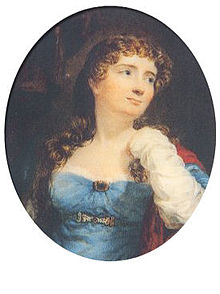Anne Noel-Byron, 11th Baroness Wentworth

Anne Isabella Noel-Byron, 11th Baroness Wentworth , better known as Lady Byron (born May 17, 1792 in Seaham , County Durham , † May 16, 1860 in London ) was a British aristocrat and the wife of the poet Lord Byron .
Life
Anne Isabella Milbanke was the only child of the English aristocrat and politician Sir Ralph Milbanke, 6th Baronet, and his wife Hon. Judith Noel († 1825), daughter of Edward Noel, 1st Viscount Wentworth (1715–1774). She was also the aunt of the Prime Minister under the reign of Queen Victoria , William Lamb, 2nd Viscount Melbourne .

Anne Isabella received a comprehensive and excellent education and was taught exclusively at home by governesses and tutors with the help of her father's library . One of her tutors was the former professor of the University of Cambridge , William Frend (1757-1841). Under his guidance she received a degree in classical literature , philosophy , science and mathematics . This lifelong fascination led Lord Byron to later call her the Princess of Parallelograms .
On January 2, 1815, Lady Anne Isabella married the aristocrat and poet George Gordon Noel Byron, 6th Baron Byron (1788-1824), son of Captain John "Mad Jack" Byron and his second wife Catherine Gordon at Seaham Hall in Country Durham . The pastor was her first cousin (illegitimate) Rev. Thomas Noel of Kirkby Mallory (1774-1853). The relationship between Byron and his wife was very tense after a short time. Annabelle also told her parents that Byron was prone to violent fits of anger. On December 10, 1815, their daughter Augusta Ada was born, who is still recognized today as a mathematician.
At the beginning of 1816 Annabelle left her husband after bitter quarrels because she no longer wanted to tolerate his relationship with his half-sister Augusta Leigh (1783–1851). Examine Francis Le Mann for a possible mental illness that would have made separation impossible under the law of the time. Since the doctor found Byron sane, Annabelle was able to enforce a permanent separation. From then on Annabelle lived with her parents with her daughter, who never met her famous father.
Lady Byron died of complications from breast cancer at the age of 67 and her remains were interred in London's Kensal Green Cemetery . Shortly before her death, Lady Byron revealed to the American writer Harriet Beecher Stowe (1811-1896) the real reason for their separation and handed over as evidence the letters that she had found in the estate of her aunt Lady Melbourne (1785-1828). The letters Lord Byron wrote to his confidante Lady Melbourne suggest an incestuous relationship between him and his half-sister Augusta , his father's daughter from his first marriage to Lady Amelia d'Arcy, Baroness Conyers. Since Augusta lived separated from her husband George Leigh since 1811, it is considered biographically probable that her daughter Elizabeth Medora, born in April 1814, was Byron's child (and thus not only the half-cousin of her daughter Ada , but also her half-sister). Lady Melbourne warned Byron of the social consequences should his inclination become public and advised him to marry soon to rehabilitate his reputation. As a result, Lord Byron became engaged to Isabella Milbanke. Harriet Beecher Stowe published the story (1869) in her book True story of Lady Byron's life , causing a storm of indignation that severely damaged Lord Byron's reputation.
Name in different phases of life
- 1792–1815 Lady Anne Isabella Milbanke
- 1815–1856 Anne Isabella Noel-Byron, Baroness Byron
- 1856–1860 Anne Isabella Noel-Byron, 11th Baroness Wentworth ( Peeress in her own right )
The title of Baron Wentworth had been inactive since her uncle's death in 1815. Possible heirs to the title were her mother and cousin Nathaniel Curzon, 3rd Baron Scarsdale . As an old English barony, the title could also be inherited in the female line if there were no sons. When the cousin died in 1856 without an heir, Noel-Byron became Baroness Wentworth .
The title then passed to the eldest grandson when Noel-Byron died, as his mother had already passed away.
literature
- Harriet Beecher Stowe: True story of Lady Byron's life (1869), Originally published in Boston by Fields, Osgood, & Co. (1870)
- Elizabeth Milbanke Lamb Melbourne: Byron's "Corbeau Blanc": The Life and Letters of Lady Melbourne , Texas A&M University Press, Jonathan David Gross (Ed.) (1997) ISBN 0-8909-6672-9
- Julia Markus: Lady Byron & her daughters , New York; London: WW Norton & Company, [2015], ISBN 978-0-393-08268-5
- Miranda Seymour: In Byron's wake: the turbulent lives of Lord Byron's wife and daughter: Annabella Milbanke and Ada Lovelace , London: Simon & Schuster, 2018, ISBN 978-1-4711-3857-7
Web links
- Anne Isabella Noel, Baroness Wentworth, on thepeerage.com , accessed August 19, 2015.
- Anne Noel Byron, 11th Baroness Wentworth in the database of Find a Grave (English)
- Annabella Milbanke (English)
- Andrea Klasen: ZeitZeichen : May 16, 1860 - Anniversary of the death of Anne Isabella Noel-Byron
| predecessor | Office | successor |
|---|---|---|
|
Thomas Noel (dormant from 1815) |
Baroness Wentworth (dormant) 1856–1860 |
Byron King-Noel |
| personal data | |
|---|---|
| SURNAME | Noel-Byron, Anne, 11th Baroness Wentworth |
| ALTERNATIVE NAMES | Noel-Byron, Anne Isabella, 11th Baroness Wentworth (full name); Byron, lady |
| BRIEF DESCRIPTION | British aristocrat, wife of the poet Lord Byron |
| DATE OF BIRTH | May 17, 1792 |
| PLACE OF BIRTH | Seaham , Durham |
| DATE OF DEATH | May 16, 1860 |
| Place of death | London |

